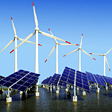- Home >
- Our Actions >
- Ambassador report
1
Comments
Understanding a Green Economy in the Context of Sustainable Development |
|---|
|
The global recession has brought new attention to chronic structural flaws in current economic models and assumptions. As economies struggle to recover, many are taking a closer look at the broad concept of a ?Green Economy,? one that simultaneously promotes sustainability and economic growth.
According to the United Nations Environment Programme (UNEP), a green economy is one whose growth in income and employment is driven by public and private investments that reduce carbon emissions and pollution, enhance energy and resource efficiency, and prevent the loss of biodiversity and ecosystem services. A Green Economy can be thought of as an alternative vision for growth and development one that can generate growth and improvements in people?s lives in ways consistent with sustainable development. A Green Economy promotes a triple bottom line: sustaining and advancing economic, environmental and social well-being. The prevailing economic growth model is focused on increasing Gross Domest above all other goals. While this system has improved incomes and reduced poverty for hundreds of millions, it comes with significant and potentially irreversible social, environmental and economic costs. Poverty persists for as many as two and a half billion people, and the natural wealth of the planet is rapidly being drawn down. In a recent global assessment, approximately 60 percent of the world?s ecosystem services were found to be degraded or used unsustainably. The gap between the rich and poor is also increasing – between 1990 and 2005, income inequality (measured by the gap between the highest and lowest income earners) rose in more than two thirds of countries. While the prevailing economic growth model focuses on increasing GDP above all other goals, a Green Economy promotes a triple bottom line: sustaining and advancing economic, environmental and social well-being. The persistence of poverty and degradation of the environment can be traced to a series of market and institutional failures that make the prevailing economic model far less effective than it otherwise would be in advancing sustainable development goals. These market and institutional failures are well known to economists, but little progress has been made to address them. For example, there are not sufficient mechanisms to ensure that polluters pay the full cost of their pollution. There are ?missing markets? – meaning that markets do not systematically account for the inherent value of services provided by nature, like water filtration or coastal protection. A ?market economy? alone cannot provide public goods, like efficient electricity grids, sanitation or public transportation. And economic policy is often shaped by those who wield power, with strong vested interests, and rarely captures the voice and perspectives of those most at risk. A Green Economy attempts to remedy these problems through a variety of institutional reforms and regulatory, tax, and expenditure-based economic policies and tools. |

|
|
|










 Previous : Rainwater harvesting populariz...
Previous : Rainwater harvesting populariz...









1 Comments
Understand the Concept of a Green Economy in the context of Sustainable development
Posted 28-08-2012 21:21